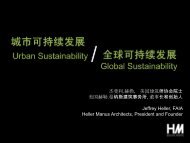Beth Day Director, FTA Office of Project Planning RailVolution ...
Beth Day Director, FTA Office of Project Planning RailVolution ...
Beth Day Director, FTA Office of Project Planning RailVolution ...
You also want an ePaper? Increase the reach of your titles
YUMPU automatically turns print PDFs into web optimized ePapers that Google loves.
• What is a New or Small Start?• New “fixed guideways” and extensions to existing systems• Includes light rail, heavy rail, commuter rail, bus rapid transit• A Discretionary & Competitive Federal Grant Program• $1.99 billion appropriated in Fiscal Year 2010• Demand for funds exceeds supply• Historical average federal New Starts share = 50%• Evaluation – As directed in law, <strong>FTA</strong> evaluates and rates projects against multiplecriteria, including land use and economic development:• Annually in a Report to Congress (due First Monday in February)• For entry into Preliminary Engineering• For entry into Final Design• Prior to Full Funding Grant Agreement (FFGA)• Record <strong>of</strong> Success – Over 100 major projects over 35 years•2
• <strong>Project</strong> Development: Typically 6-12 Years<strong>FTA</strong>ApprovalRequired<strong>FTA</strong>ApprovalRequired<strong>FTA</strong> ApprovalRequired forFull Funding GrantAgreement (FFGA)AlternativesAnalysis1-2 yearsPreliminaryEngineering2-3 yearsFinal Design3-7 yearsConstructionOperationSome local keys to accelerate a project: consensus (route, mode,stations), funding, and environmental work
• Land Use• Existing population and employment within ½ mile <strong>of</strong> stationareas• Economic Development• Transit Supportive Plans and Policies• Growth Management• Transit Supportive Corridor Policies• Supportive Zoning Near Transit Stations• Tools to Implement Land Use Policies• Performance and Impact <strong>of</strong> Plans and Policies• Demonstrated cases <strong>of</strong> TOD• Station area development proposals and status• Adaptability <strong>of</strong> station area land for development• Corridor economic development
• Concentration <strong>of</strong> development around regionalactivity centers and transit• Regional plans• Regulatory or fiscal incentives• “Smart Growth” policies, comprehensive plans, and zoning• Land conservation and management• Growth management boundaries• Preservation <strong>of</strong> open space, sensitive habitat, farmland, orareas <strong>of</strong> rural character• Incentive or mandates for land conservation• Actual land conservation purchases or designations
• Plans and policies to increase corridor and station area development• Benchmarks for floor area ratios or residential dwelling units• Planned high trip generators in the corridor• Plans and policies to enhance transit-friendly character• Mix <strong>of</strong> land uses• Building design characteristics (facades, windows, setbacks, height limits)• Plans to improve pedestrian facilities, including facilities for persons withdisabilities• Capital improvement programs for sidewalks, connected pedestrian paths,street crossings, and facilities for persons with disabilities• Adopted or proposed design guidelines• Parking policies• Parking limits• Provisions for shared parking• Parking fees
• Existing and proposed zoning that supports increaseddevelopment density in transit station areas• Density bonuses• Housing fund subsidies• Expedited zoning reviews• Zoning ordinances that enhance transit-oriented character <strong>of</strong>station areas• Mixed use zoning• Ordinances addressing placement <strong>of</strong> building footprints, pedestrianfacilities, façade treatments• Architectural guidance• Zoning allowances for reduced parking and traffic mitigation• Minimum and/or maximum parking requirements for residential andcommercial development
• Outreach to and endorsement by public agencies, communityorganizations, and the general public in the planning process• Outreach program• Resolutions, letters <strong>of</strong> endorsement etc.• Regulatory and financial incentives to promote TOD• Density bonuses• Streamlined processing <strong>of</strong> development applications• Reduced or waived zoning requirements for traffic mitigation fees• Tax increment financing zones, tax abatement or TOD loan support• Revitalization strategies• Efforts to involve the development community• TOD market studies• Joint development strategy
• <strong>FTA</strong> applies a higher standard as projects progress from preliminaryengineering to final design• At entry into PE, conceptual plans should be underway and work withlocal jurisdictions should have begun:• Transit oriented development proposals drafted• Discussions held with local jurisdictions about revising comprehensive plans,master area plans and station area plans• Identification <strong>of</strong> capital improvements for station areas• Initiation <strong>of</strong> public outreach efforts• At entry into FD, must show some demonstrated progress onimplementation <strong>of</strong> plans and policies such as:• Plans and policies adopted;• Development proposals underway;• Regulatory <strong>of</strong> financial incentives adopted; and/or• Zoning changes implemented.
• New Starts project sponsors are typically transitagencies that have no defined role in local landuse planning• Land use and economic development plans andpolicies are critical to a successful project ratingand receipt <strong>of</strong> Federal funding
















